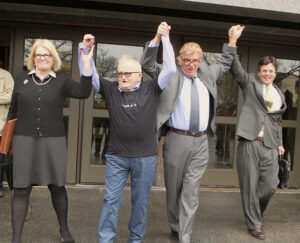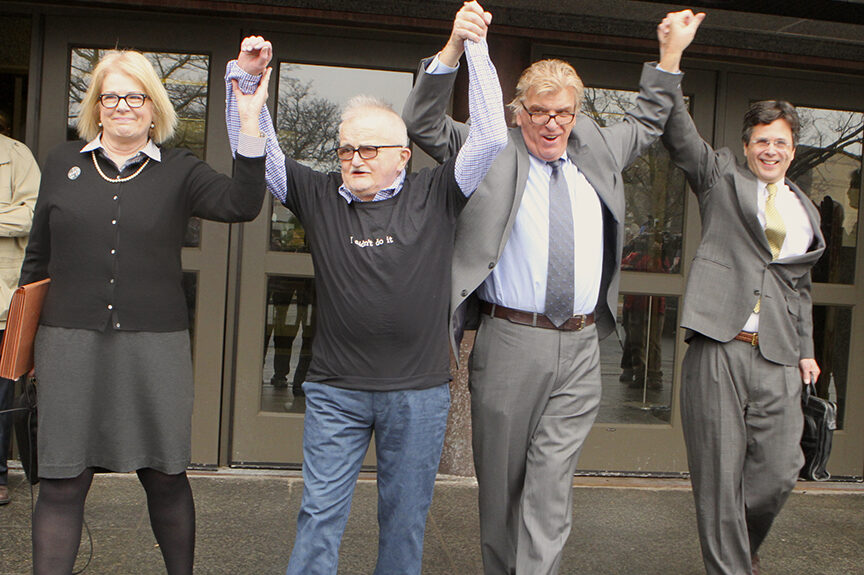Criminal Justice
Setting Free the Wrongfully Convicted
By Lucia Shen
Spectrum staff
In 1974, a Philadelphia judge sentenced 17-year-old Edward Baker to life in prison for murder and robbery, crimes he couldn’t have committed. He was at a funeral wake 12 miles away at the time police said the crimes happened.
“December the 23rd,” Baker said, “was the day I got locked up …They kept me at the police station for three days. They beat the dog stuff out of me, made me sign a statement … They beat me for three days. I think they gave me, like, a hamburger or something.”
In the early days after a jury pronounced him guilty, his mother visited him in prison. She was the only visitor. She died while he was still incarcerated.
Determined to clear his name and get out from behind bars, he wrote to John McCloskey, founder of Centurion, an organization that investigates and lobbies to reopen court cases of wrongfully convicted individuals. In 1991, McCloskey was Baker’s only visitor to the Texas prison where he had been transferred after the notorious 1989 riots at his old Pennsylvania state prison.
“It was like automatic stuff when Jim came,” Baker said.
McCloskey believed him. McCloskey’s work on Baker’s behalf got him set free after 26 years behind bars, plus two years under house arrest while a Philadelphia prosecutor fought against a retrial but eventually gave in. In 2002, that prosecutor dropped all charges against Baker.
~~~~~~~~~~~~~~~~~~~
The office lights had just come back on when Kate Germond answered the telephone.
“Nothing’s ever a good time,” Germond, Centurion’s senior investigator and former executive director, said, laughing. “On top of everything else we just had a power surge, and our building was plunged into darkness.”
Since its start in 1983, Centurion has won exonerations for 63 people, including Baker, from all across the country. The organization receives 1,100 to 1,200 new requests for help every year. Right now, it’s working 20 cases.
“The folks who write to us are writing to us because nobody else could help them,” said Germond, who has been with Centurion since the beginning.
Originally from Mendocino, California, she moved to New York City in 1986. She read about McCloskey’s work to exonerate Nathaniel Walker in The New York Times. The two met in New York City in January 1987 and starting working to expand Centurion.
Every case is a years-long undertaking, beginning with the staff’s unanimous vote to take on a case. They begin by collecting a motherlode of case documents and conducting three- to five-hour long interviews with incarcerated people.
“We’re certainly spending a lot of time trying to calm people down,” Germond said, “so, we can literally have a freewheeling, open-ended conversation about their case, their story, what happened to them.”
Centurion’s involvement does not stop after it helps to free a person. They had had a hard enough time in prison and often have difficulties adjusting to life outside of prison, in a world they are not so familiar with anymore.
“We had this man who had a cognitive deficit,” Germond said. “And, right now, he’s fighting Covid, and he doesn’t understand what’s going on … When we got him freed, he thought he was going to get to go back to his wife and children, his son who is now, of course, a grown man because he’s been inside for more than thirty years … He thought he was going to go back to his family, and he’s not, and … “
She paused.
“And now he’s dying because of Covid. And, so, you know, my heart’s broken … We can’t fix that for him.”
Cases like those stir something within that keeps her doing what she does. “Rage,” she said.
Again, she paused. One second, two seconds, three seconds … “I’m really angry at the criminal justice system and what’s happened to all these people.”
~~~~~~~~~~~~~~~~~~~
Mark Schand, another Centurion client, was sentenced to life without parole. He served 27 years for a murder he did not commit before being freed in 2013. He was in Hartford, Conn., at the salon where his girlfriend worked, when an innocent bystander was killed during a Springfield, Mass., armed robbery.
“It was an out-of-body experience,” he said, of sitting through his trial. “You know, at times, I couldn’t believe I was really on trial for it … I thought, somewhere between being arrested and the trial, someone would say, ‘That’s not the guy,’ and I’d come home. But that wasn’t the case.”

Kate Germond and her colleagues with Richard Lapointe after his exoneration. (Photo courtesy of Kate Germond)
Black people are seven times more likely than white people to be wrongfully convicted of murder, according to The National Registry of Exonerations.
“Not to play the race card, but it has a little something to do with it,” said Schand, who is black. “It definitely has a little something to do with it. If my wife and kids were blonde hair, blue-eyed, there would have been outrage about what happened to me.”
African Americans make up approximately 13.4 percent of the U.S. population, according to the Census Bureau’s July 2019 estimates. They are 47 percent of exonorees in the national registry, a disparity that partly reflects how over-represented blacks are in prisons.
In 2019 alone, there were 143 exonerations nationwide, some won by other organizations, including The Sentencing Project.
~~~~~~~~~~~~~~~~~~~
Ed Baker lost some things during 28 years behind bars. He also trained to become an electrician, the trade he retired from after working for 16 years for the City of Philadelphia.
Asked about his life after prison, he paused. One second, two seconds … nine seconds. Then, a chuckle. “Well,” he started. “I’ve been home now, for 21 years. Those years? I think were okay. Could have been better.”



